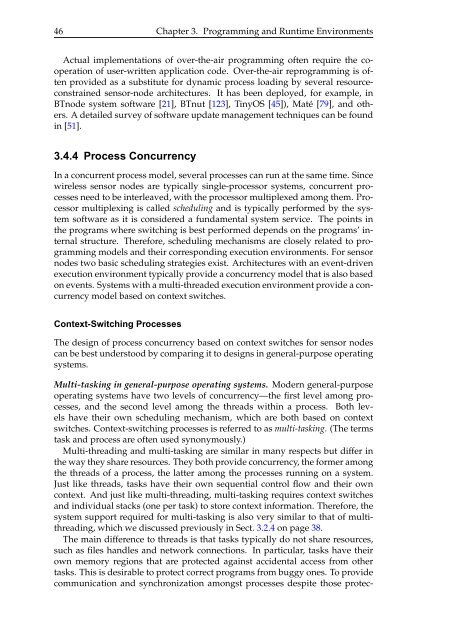A State-Based Programming Model for Wireless Sensor Networks
A State-Based Programming Model for Wireless Sensor Networks
A State-Based Programming Model for Wireless Sensor Networks
Create successful ePaper yourself
Turn your PDF publications into a flip-book with our unique Google optimized e-Paper software.
46 Chapter 3. <strong>Programming</strong> and Runtime Environments<br />
Actual implementations of over-the-air programming often require the cooperation<br />
of user-written application code. Over-the-air reprogramming is often<br />
provided as a substitute <strong>for</strong> dynamic process loading by several resourceconstrained<br />
sensor-node architectures. It has been deployed, <strong>for</strong> example, in<br />
BTnode system software [21], BTnut [123], TinyOS [45]), Maté [79], and others.<br />
A detailed survey of software update management techniques can be found<br />
in [51].<br />
3.4.4 Process Concurrency<br />
In a concurrent process model, several processes can run at the same time. Since<br />
wireless sensor nodes are typically single-processor systems, concurrent processes<br />
need to be interleaved, with the processor multiplexed among them. Processor<br />
multiplexing is called scheduling and is typically per<strong>for</strong>med by the system<br />
software as it is considered a fundamental system service. The points in<br />
the programs where switching is best per<strong>for</strong>med depends on the programs’ internal<br />
structure. There<strong>for</strong>e, scheduling mechanisms are closely related to programming<br />
models and their corresponding execution environments. For sensor<br />
nodes two basic scheduling strategies exist. Architectures with an event-driven<br />
execution environment typically provide a concurrency model that is also based<br />
on events. Systems with a multi-threaded execution environment provide a concurrency<br />
model based on context switches.<br />
Context-Switching Processes<br />
The design of process concurrency based on context switches <strong>for</strong> sensor nodes<br />
can be best understood by comparing it to designs in general-purpose operating<br />
systems.<br />
Multi-tasking in general-purpose operating systems. Modern general-purpose<br />
operating systems have two levels of concurrency—the first level among processes,<br />
and the second level among the threads within a process. Both levels<br />
have their own scheduling mechanism, which are both based on context<br />
switches. Context-switching processes is referred to as multi-tasking. (The terms<br />
task and process are often used synonymously.)<br />
Multi-threading and multi-tasking are similar in many respects but differ in<br />
the way they share resources. They both provide concurrency, the <strong>for</strong>mer among<br />
the threads of a process, the latter among the processes running on a system.<br />
Just like threads, tasks have their own sequential control flow and their own<br />
context. And just like multi-threading, multi-tasking requires context switches<br />
and individual stacks (one per task) to store context in<strong>for</strong>mation. There<strong>for</strong>e, the<br />
system support required <strong>for</strong> multi-tasking is also very similar to that of multithreading,<br />
which we discussed previously in Sect. 3.2.4 on page 38.<br />
The main difference to threads is that tasks typically do not share resources,<br />
such as files handles and network connections. In particular, tasks have their<br />
own memory regions that are protected against accidental access from other<br />
tasks. This is desirable to protect correct programs from buggy ones. To provide<br />
communication and synchronization amongst processes despite those protec-
















